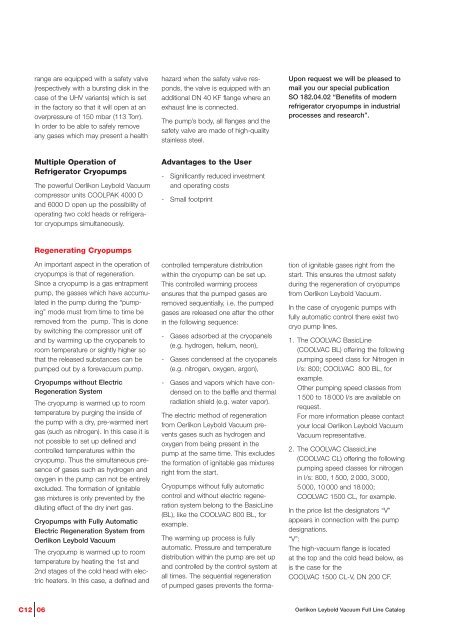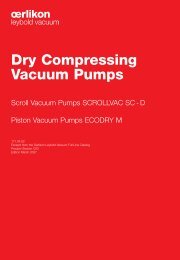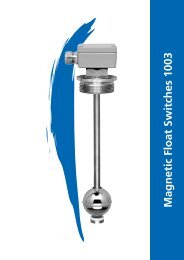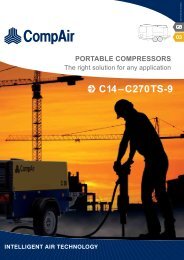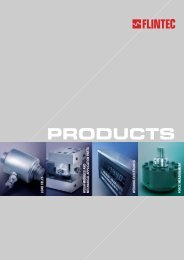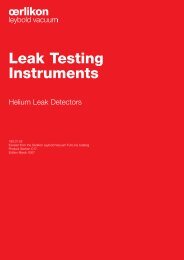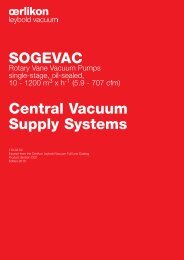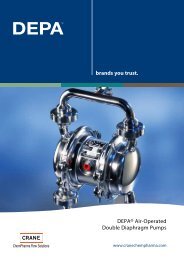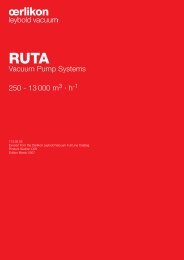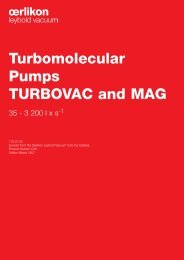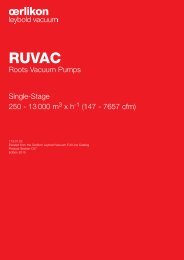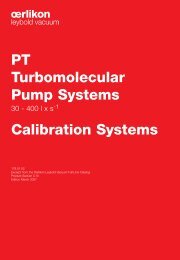Cryopumps, Cryogenics - Granzow
Cryopumps, Cryogenics - Granzow
Cryopumps, Cryogenics - Granzow
You also want an ePaper? Increase the reach of your titles
YUMPU automatically turns print PDFs into web optimized ePapers that Google loves.
ange are equipped with a safety valve<br />
(respectively with a bursting disk in the<br />
case of the UHV variants) which is set<br />
in the factory so that it will open at an<br />
overpressure of 150 mbar (113 Torr).<br />
In order to be able to safely remove<br />
any gases which may present a health<br />
hazard when the safety valve responds,<br />
the valve is equipped with an<br />
additional DN 40 KF flange where an<br />
exhaust line is connected.<br />
The pump’s body, all flanges and the<br />
safety valve are made of high-quality<br />
stainless steel.<br />
Upon request we will be pleased to<br />
mail you our special publication<br />
SO 182.04.02 “Benefits of modern<br />
refrigerator cryopumps in industrial<br />
processes and research”.<br />
Multiple Operation of<br />
Refrigerator <strong>Cryopumps</strong><br />
The powerful Oerlikon Leybold Vacuum<br />
compressor units COOLPAK 4000 D<br />
and 6000 D open up the possibility of<br />
operating two cold heads or refrigerator<br />
cryopumps simultaneously.<br />
Advantages to the User<br />
- Significantly reduced investment<br />
and operating costs<br />
- Small footprint<br />
Regenerating <strong>Cryopumps</strong><br />
An important aspect in the operation of<br />
cryopumps is that of regeneration.<br />
Since a cryopump is a gas entrapment<br />
pump, the gasses which have accumulated<br />
in the pump during the “pumping”<br />
mode must from time to time be<br />
removed from the pump. This is done<br />
by switching the compressor unit off<br />
and by warming up the cryopanels to<br />
room temperature or sightly higher so<br />
that the released substances can be<br />
pumped out by a forevacuum pump.<br />
<strong>Cryopumps</strong> without Electric<br />
Regeneration System<br />
The cryopump is warmed up to room<br />
temperature by purging the inside of<br />
the pump with a dry, pre-warmed inert<br />
gas (such as nitrogen). In this case it is<br />
not possible to set up defined and<br />
controlled temperatures within the<br />
cryopump. Thus the simultaneous presence<br />
of gases such as hydrogen and<br />
oxygen in the pump can not be entirely<br />
excluded. The formation of ignitable<br />
gas mixtures is only prevented by the<br />
diluting effect of the dry inert gas.<br />
<strong>Cryopumps</strong> with Fully Automatic<br />
Electric Regeneration System from<br />
Oerlikon Leybold Vacuum<br />
The cryopump is warmed up to room<br />
temperature by heating the 1st and<br />
2nd stages of the cold head with electric<br />
heaters. In this case, a defined and<br />
controlled temperature distribution<br />
within the cryopump can be set up.<br />
This controlled warming process<br />
ensures that the pumped gases are<br />
removed sequentially, i.e. the pumped<br />
gases are released one after the other<br />
in the following sequence:<br />
- Gases adsorbed at the cryopanels<br />
(e.g. hydrogen, helium, neon),<br />
- Gases condensed at the cryopanels<br />
(e.g. nitrogen, oxygen, argon),<br />
- Gases and vapors which have condensed<br />
on to the baffle and thermal<br />
radiation shield (e.g. water vapor).<br />
The electric method of regeneration<br />
from Oerlikon Leybold Vacuum prevents<br />
gases such as hydrogen and<br />
oxygen from being present in the<br />
pump at the same time. This excludes<br />
the formation of ignitable gas mixtures<br />
right from the start.<br />
<strong>Cryopumps</strong> without fully automatic<br />
control and without electric regeneration<br />
system belong to the BasicLine<br />
(BL), like the COOLVAC 800 BL, for<br />
example.<br />
The warming up process is fully<br />
automatic. Pressure and temperature<br />
distribution within the pump are set up<br />
and controlled by the control system at<br />
all times. The sequential regeneration<br />
of pumped gases prevents the formation<br />
of ignitable gases right from the<br />
start. This ensures the utmost safety<br />
during the regeneration of cryopumps<br />
from Oerlikon Leybold Vacuum.<br />
In the case of cryogenic pumps with<br />
fully automatic control there exist two<br />
cryo pump lines.<br />
1. The COOLVAC BasicLine<br />
(COOLVAC BL) offering the following<br />
pumping speed class for Nitrogen in<br />
l/s: 800; COOLVAC 800 BL, for<br />
example.<br />
Other pumping speed classes from<br />
1 500 to 18 000 l/s are available on<br />
request.<br />
For more information please contact<br />
your local Oerlikon Leybold Vacuum<br />
Vacuum representative.<br />
2. The COOLVAC ClassicLine<br />
(COOLVAC CL) offering the following<br />
pumping speed classes for nitrogen<br />
in l/s: 800, 1 500, 2 000, 3 000,<br />
5 000, 10 000 and 18 000;<br />
COOLVAC 1500 CL, for example.<br />
In the price list the designators “V”<br />
appears in connection with the pump<br />
designations.<br />
“V”:<br />
The high-vacuum flange is located<br />
at the top and the cold head below, as<br />
is the case for the<br />
COOLVAC 1500 CL-V, DN 200 CF.<br />
C12 06<br />
Oerlikon Leybold Vacuum Full Line Catalog


